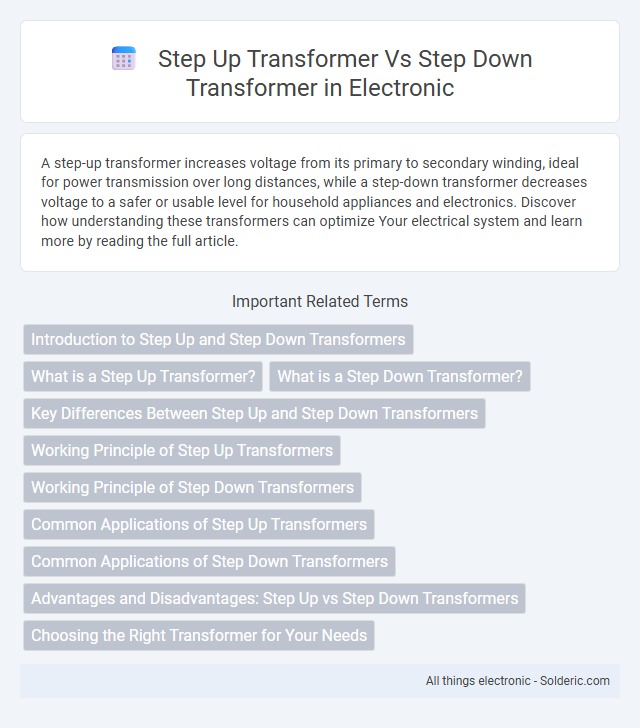A step-up transformer increases voltage from its primary to secondary winding, ideal for power transmission over long distances, while a step-down transformer decreases voltage to a safer or usable level for household appliances and electronics. Discover how understanding these transformers can optimize Your electrical system and learn more by reading the full article.
Comparison Table
| Feature | Step-Up Transformer | Step-Down Transformer |
|---|---|---|
| Function | Increases voltage from primary to secondary | Decreases voltage from primary to secondary |
| Voltage Ratio | Secondary voltage > Primary voltage | Secondary voltage < Primary voltage |
| Turns Ratio | Secondary turns > Primary turns | Secondary turns < Primary turns |
| Current Behavior | Secondary current < Primary current | Secondary current > Primary current |
| Applications | Power transmission, voltage stepping for transmission lines | Electronics, power supply, voltage reduction for devices |
| Energy Efficiency | High, minimal energy loss during voltage increase | High, minimal energy loss during voltage decrease |
Introduction to Step Up and Step Down Transformers
Step up transformers increase voltage from the primary to the secondary coil, making them essential for long-distance power transmission by reducing current and minimizing energy loss. Step down transformers decrease voltage, making electricity safer and usable for homes and electronic devices. Your choice between these transformers depends on whether you need to boost voltage for efficient transport or reduce it for practical consumption.
What is a Step Up Transformer?
A step up transformer is an electrical device designed to increase voltage from a lower primary coil to a higher secondary coil while decreasing current proportionally. It operates on the principle of electromagnetic induction, utilizing a higher number of turns in the secondary winding compared to the primary. This type of transformer is commonly used in power transmission to boost voltage levels for efficient long-distance electricity distribution.
What is a Step Down Transformer?
A step down transformer reduces high voltage from the primary winding to a lower voltage in the secondary winding, making electrical power safer and more suitable for household or industrial use. It achieves voltage reduction through a greater number of primary coil turns compared to the secondary coil, maintaining power consistency by adjusting current accordingly. Understanding how your device interacts with a step down transformer ensures proper voltage compatibility and prevents electrical damage.
Key Differences Between Step Up and Step Down Transformers
Step up transformers increase voltage from the primary to the secondary coil, making them essential for power transmission across long distances by reducing current and minimizing energy loss. Step down transformers decrease voltage to a safer, usable level for homes and businesses, ensuring electrical appliances operate efficiently without damage. Understanding whether your application requires voltage elevation or reduction determines the appropriate transformer type for optimal performance and safety.
Working Principle of Step Up Transformers
Step-up transformers operate on the principle of electromagnetic induction, where the primary coil receives alternating current, creating a magnetic flux that induces a higher voltage in the secondary coil with more turns. The voltage increase corresponds to the ratio of turns between the secondary and primary windings, allowing efficient voltage transformation for long-distance power transmission. This transformer type is crucial in electrical grids to boost voltage levels from power plants before distribution.
Working Principle of Step Down Transformers
Step down transformers operate based on the principle of electromagnetic induction, where an alternating current in the primary coil generates a magnetic flux that induces a lower voltage in the secondary coil due to fewer windings. The voltage reduction is proportional to the ratio of turns between the primary and secondary coils, enabling conversion from high voltage to a safer, lower voltage for practical applications. This efficient voltage transformation is essential in power distribution systems to minimize energy loss and ensure compatibility with household or industrial devices.
Common Applications of Step Up Transformers
Step-up transformers are commonly used in power generation plants to increase voltage levels for efficient long-distance electricity transmission, minimizing power loss. They are also essential in electrical substation operations to elevate voltage before distribution to high-voltage transmission lines. Additionally, step-up transformers are utilized in devices such as cathode ray tube televisions and microwave ovens to provide the high voltage necessary for operation.
Common Applications of Step Down Transformers
Step down transformers are widely used in household electrical systems to reduce high voltage from power lines to safer, usable levels typically ranging from 110V to 240V. These transformers are essential in power adapters, electronic devices, and industrial machinery where low voltage is required for safe and efficient operation. They also play a critical role in lighting systems, voltage regulation, and electrical distribution within residential and commercial buildings.
Advantages and Disadvantages: Step Up vs Step Down Transformers
Step up transformers increase voltage while decreasing current, making them ideal for long-distance power transmission with minimal energy loss, but they can be more expensive and less efficient at low loads. Step down transformers reduce voltage to safer, usable levels for homes and businesses, offering higher efficiency and safety, though they may suffer greater energy loss if used incorrectly over long distances. Your choice depends on whether you need to boost voltage for transmission or lower voltage for distribution and use.
Choosing the Right Transformer for Your Needs
Step up transformers increase voltage from a lower input to a higher output, ideal for long-distance power transmission to reduce energy loss. Step down transformers decrease voltage from a higher input to a lower output, suitable for safely powering household or business electrical devices. Your choice depends on whether you need to elevate voltage for efficient transport or reduce it for safe, practical use.
step up transformer vs step down transformer Infographic

 solderic.com
solderic.com